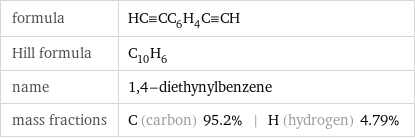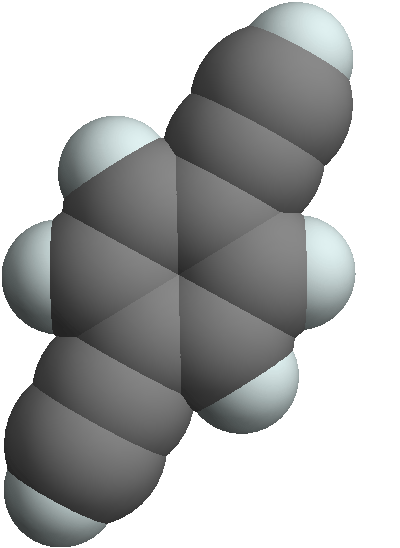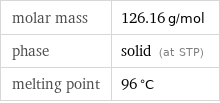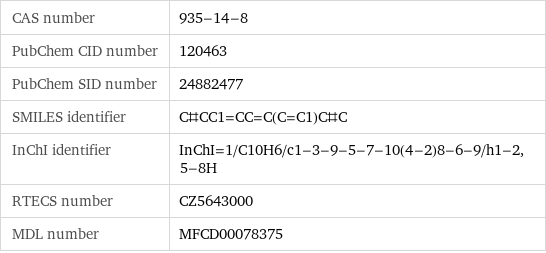Input interpretation

1, 4-diethynylbenzene
Chemical names and formulas

formula | HC congruent CC_6H_4C congruent CH Hill formula | C_10H_6 name | 1, 4-diethynylbenzene mass fractions | C (carbon) 95.2% | H (hydrogen) 4.79%
Lewis structure

Draw the Lewis structure of 1, 4-diethynylbenzene. Start by drawing the overall structure of the molecule, ignoring potential double and triple bonds: Count the total valence electrons of the carbon (n_C, val = 4) and hydrogen (n_H, val = 1) atoms: 10 n_C, val + 6 n_H, val = 46 Calculate the number of electrons needed to completely fill the valence shells for carbon (n_C, full = 8) and hydrogen (n_H, full = 2): 10 n_C, full + 6 n_H, full = 92 Subtracting these two numbers shows that 92 - 46 = 46 bonding electrons are needed. Each bond has two electrons, so in addition to the 16 bonds already present in the diagram add 7 bonds. To minimize formal charge carbon wants 4 bonds. Identify the atoms that want additional bonds and the number of electrons remaining on each atom: Fill in the 7 bonds by pairing electrons between adjacent highlighted atoms. Note that the six atom ring is aromatic, so that the single and double bonds may be rearranged: Answer: | |
3D structure

3D structure
Basic properties

molar mass | 126.16 g/mol phase | solid (at STP) melting point | 96 °C
Units

Chemical identifiers

CAS number | 935-14-8 PubChem CID number | 120463 PubChem SID number | 24882477 SMILES identifier | C#CC1=CC=C(C=C1)C#C InChI identifier | InChI=1/C10H6/c1-3-9-5-7-10(4-2)8-6-9/h1-2, 5-8H RTECS number | CZ5643000 MDL number | MFCD00078375